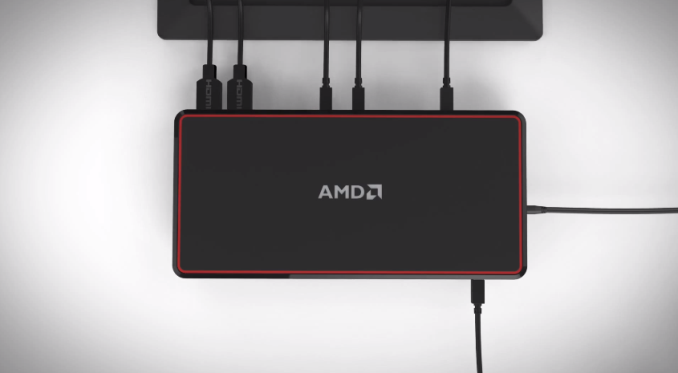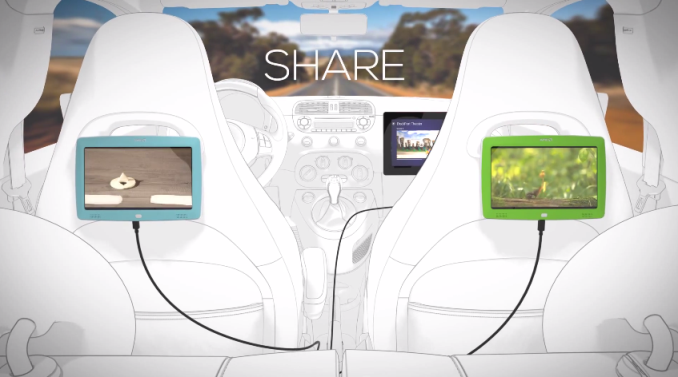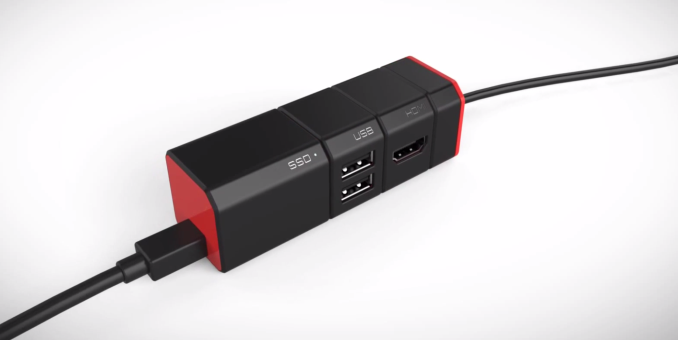AMD’s DockPort Given Virtual Overview
by Ian Cutress on February 13, 2014 4:58 AM EST- Posted in
- AMD
- DisplayPort
- DockPort

Flying somewhat under the radar, DockPort from AMD is designed to be a low-cost all-in-one solution for external connectivity for a PC or tablet. Sound familiar? Like Thunderbolt familiar? This is AMD’s solution to the issue of connectivity, using the DisplayPort connector to transfer USB information as well as audio/visual.
Not a lot has been said about DockPort, despite originally being given a name sometime in 2012, but since CES 2014 has been adopted as an official DisplayPort standard extension by VESA with a finalized standard expected in Q2. With the combination of DisplayPort and USB 3.0 over a single cable, AMD’s video explains it best how it can be used:
To list the possible uses:
- Charging (over USB 3.0 standard we would assume)
- Docking to an external keyboard/battery/audio
- Connecting Storage, Audio outputs, Video outputs, USB hubs
- Share video or run multiple video screens
Basically this is everything USB can do, including video stream via DisplayPort, albeit in a single interface that is already standard across many systems and form factors. AMD have not specified what extra hardware is needed beyond DisplayPort compatibility (presumably the next iteration of the DisplayPort standard) or whether this extension is just for limited use with a bridge chip. DockPort verified cables will be needed, and no idea on the cost of those this early in the development cycle, or whether the standard will be roped into DisplayPort fundamentally. The main competition is of course with Intel's Thunderbolt, where one of the features I am most looking forward to is Graphics over TB. That will not be possible with DockPort, but it will try to do everything else it seems, although it does seem to suggest that DockPort will be limited to USB 3.0 for any data-related daisy chaining, unless AMD have an ace up their sleeve.
I would imagine AMD would tie this technology into their desktop motherboard line, as well as their SoCs, when it is ready which might increase adoption rates faster than Thunderbolt. Having both interfaces use a similar sort of connector asks the question whether the two interfaces might be coherent in the same output/input, making future devices (namely storage) able to use both in one connector rather than have specific DockPort/TB inputs.
This is still early days, given the computer generated nature of AMD’s video. Computex is still several months away – we might see an real world update then. Looking forward to it…!


















52 Comments
View All Comments
Mobile-Dom - Thursday, February 13, 2014 - link
i really want DockPort to be a thing, and i reckon it will be, but unfortunatly i dont think it will be in a reasonable amount of time, which upsets me, the idea of Dockport (and by extension Thunderolt) is great, one cable for essentially everything, it just hasnt happened with thunderbolt becasue its too dang expensive, and i dont think AMD will make DockPort a think in a timely fashion because, well thats what AMD seems to do, they're like "hey look at this awesome thing... go finish it" which, well sucksfteoath64 - Thursday, February 13, 2014 - link
It makes existing USB3 standard more usable and more flexible rather than adopt a different standard like TB that is both costly in terms of chipset and cables, yet do a bit more. The PC industry cannot afford a more expensive thing for peripherals in order to go mainstream. USB2 took some time to be mainstream and USB3 should well accelerate that as will Sata Express.The idea is to keep extending the existing standard with faster speed and higher bandwidth to keep up with the processing ability of the cpu/gpu. Also storage capabilities.
Mobile-Dom - Thursday, February 13, 2014 - link
like i said, i really want it to happen, i mean hey, DockPort should technically be able to do more than thunderbot should it not? USB Vs. PCIe? i could be wrong though.i want it to happen, but the pessimist in me is saying it wont.
though i hope my next notebook/desktop has a Dockport port
Ian Cutress - Thursday, February 13, 2014 - link
With PCIe you can add any PCIe to X controller to get that functionality. All modern USB 3.0/SATA 6 Gbps controllers use PCIe 2.0 lanes from the chipset, for example, and there are plenty of PCIe to X cards out there. Thunderbolt also has a throughput boost, being able to use PCIe, meaning more daisy chaining possible. The concern there, as always is cost. TB is more expensive, but is more versatile.I've maintained a story for a number of years now - when the USB media kits I get at events are all USB 3.0, then USB 3.0 has a proper foot into normal use scenarios. Last year at Computex it was 50% USB 3.0, 50% USB 2.0, so there's still room for improvement if these companies are using the cheapest solution to distribute 50MB+ images. All new standards have this adoption lag, although additions to current standards might be adopted more quickly - it is hard to say.
BMNify - Thursday, February 13, 2014 - link
its a shame given the time lag since the initial dockport announcment that we dont see USB3.1 being taken as the default for this relaunch and where is the mention of official far faster Ethernet over USB3/3.1 networking that i seem to remember being a base option way back when originally speced...HisDivineOrder - Thursday, February 13, 2014 - link
I thought the same.repoman27 - Thursday, February 13, 2014 - link
What you need to take into account is the time lag that will occur before certified USB 3.1 XHCI silicon is widely available, which will really be when AMD and Intel integrate it into their chipsets. For Intel that will mean what, Skylake at the earliest? I'm sure AMD will get there sooner than that, and DockPort is their baby, but realistically, waiting for USB 3.1 would be pointless.SirKnobsworth - Friday, February 14, 2014 - link
Skylake would make sense. That's when they're moving the secondary PCIe lanes to 3.0 as well (according to leaked roadmaps), which will mean an upgrade of the entire high speed IO controller on the chipset. USB 3.1 and PCIe 3.0 both have comparable speeds so it makes sense to do them at the same time.Sahrin - Friday, February 14, 2014 - link
How much do you guys get paid by Intel to emphasize weakness of USB in the face of Thunderbolt? Seriously.There is zero reason that Thunderbolt should exist or even be discussed, except to pad Intel's bottom line. Stop talking about it, and Intel might just release the next HCI on time and we won't have to wait two years for USB3 to become the standard.
lmcd - Saturday, February 15, 2014 - link
Umm an external GPU dock is still really, really desirable.I think the market for such a thing is being underestimated, as well as the marketing opportunity that could accompany it.